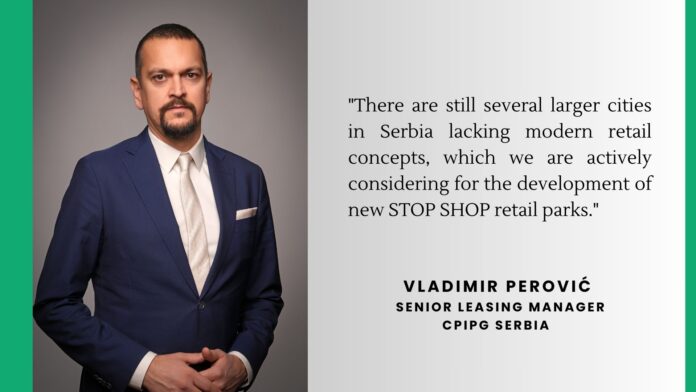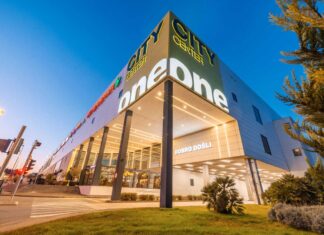CPIPG, one of the largest retail park operators in Serbia, shares how they will continue to grow their STOP SHOP network across the country.
CPIPG Serbia, part of CPI Property Group, operates 14 STOP SHOP retail parks in the country and has more in the pipeline.
We spoke with Vladimir Perović, Senior Leasing Manager at CPIPG, to get insights into the latest retail park trends in Serbia, the current state of the market, and how the developer envisions the future of retail parks in the country.
1. STOP SHOP is one of the largest retail park networks in Serbia, so what drove your decision to invest in retail park developments in this market? Are retail parks still considered a strong investment, and what is the current average yield?

CPIPG recognized the untapped potential in the Serbian market, particularly in secondary cities underserved by modern retail concepts.
Ten years ago, when few believed in the retail park format as a viable shopping and leisure destination, CPIPG had a clear vision. We knew that our wide market coverage would be highly attractive to retailers focused on expansion, as we could offer them multiple locations and help accelerate their growth.
The average yield ranges between 8.75% and 9%, which is a very satisfying result.
Given that CPIPG Serbia is actively considering the acquisition of competing projects, this yield can be considered highly stable and competitive, further confirming the attractiveness of our investments.
2. What are the current average rental rates for retail parks in Serbia, including marketing and service fees? Have these costs increased or decreased, and what factors have influenced these trends?
Rental rates in retail parks vary depending on multiple factors, including the specific city, park size, location, unit size, current market conditions, and the company’s strategic goals at the time.
Considering both shopping centers and retail parks, average rents currently range between €14 and €17 per square meter.
3. Despite fewer new retailers entering the market, is there still strong demand for additional retail park space in Serbia?

Retail park development in Serbia is still active.
Practically every smaller city is expected to have its own retail park, tailored in size and tenant mix to local market needs. Some mid-sized cities will soon host two retail parks.
CPIPG views this as a positive trend!
Healthy competition encourages greater efficiency and improves the overall business environment. At the same time, consumers benefit from greater choice.
STOP SHOP currently operates in 14 locations in Serbia, with nearly 132,000 m2 of leasable space.
There are still several larger cities lacking modern retail concepts, which CPIPG is actively considering for new STOP SHOP locations.
4. Which retail categories are currently performing best within retail parks, and how does this compare to five years ago?

Retail categories that have experienced significant growth include drugstores, supermarkets, DIY, and sporting goods.
Overall, our STOP SHOP tenants have shown steady annual sales growth since the pandemic.
This trend is largely due to the convenience of retail parks—open-air layouts, quick and efficient shopping without long stays, and parking directly in front of stores.
Additionally, the tenant mix in retail parks increasingly resembles that of shopping malls, enhancing their attractiveness. Retail parks also appeal to tenants because they offer significantly lower rental costs than shopping centers.
When comparing the turnover achieved with lower rent levels, the ratio is highly favorable for retailers, enabling stable and continuous growth.
5. How has the ideal tenant mix for retail parks evolved? Do you believe retail parks need to offer more than just shopping to remain competitive, evolving into community hubs in response to the rise of e-commerce? What strategies are you implementing to attract and engage the local community?
In today’s competitive environment and with increasing pressure from e-commerce, tenant mix is more important than ever!
It directly influences footfall and overall tenant performance.
Establishing a well-balanced mix of categories creates a synergistic effect that benefits all retailers. CPIPG is very mindful of this and doesn’t focus solely on commercial criteria. In recent years, we’ve placed more emphasis on entertainment, leisure, and new F&B concepts. This is especially true in smaller cities, where people don’t just come to shop—they come to spend time with family and meet friends.
This approach allows us to proactively respond to market changes and strengthen our positioning. Through strategic marketing and close collaboration with our tenants, we aim to create unique visitor experiences. We organize seasonal events, themed promotions, and special shopping days tailored to specific goals and target audiences.
This helps us build brand awareness and foster long-term emotional connections with visitors.
6. Is there increasing demand for small and mid-sized retail units within retail parks? If so, what is driving this shift?

In recent years, the demand for mid-sized and large-format units has grown significantly.
A decade ago, there was more interest in smaller units (up to 150 m2), typically leased by local retailers. Today, this has changed. The arrival of new brands with standard larger formats, the expansion of product ranges by existing tenants, and the integration of non-core product corners are driving this shift.
Additionally, due to labor market challenges and high staff turnover, retailers prefer larger spaces where they can present their full range with fewer employees and reduce reliance on long-term staffing.
7. What types of services and entertainment do you offer within your retail parks?
CPIPG is increasingly focused on enriching its retail parks with additional services and entertainment.
Beyond standard offerings like currency exchanges and ATMs, we now include car washes, EV chargers, parcel lockers, milk vending machines, and more. There is also growing demand for modern play areas within restaurants and cafés, and we’re actively working on implementing them.
STOP SHOP centers regularly host events that add energy and appeal to the space—concerts, birthday parties, prize contests, and themed events such as Valentine’s Day, Women’s Day, Easter, Christmas, and Back to School campaigns.
8. Are you currently investing in expansions or renovations of your existing retail parks? If so, can you share details about these projects and the reasons behind these investments?

Every STOP SHOP retail park is built according to our internal guidelines and high standards.
Projects acquired through acquisition have undergone rebranding to align with our visual identity. CPIPG invests significantly in the appearance of its parks, which strengthens our market recognition. From the beginning, we purchased additional plots around each development to allow for future expansion.
Recently, we launched second phases in Požarevac, Vršac, Sremska Mitrovica, and most recently, Subotica. A second phase is currently being prepared in Smederevo, which will add around 8,000 m2 of space. Interest from both domestic and international brands for this expansion has already been confirmed.
These extensions allow us to introduce new brands and categories, improve the tenant mix, and boost visitor numbers.
9. Do you have plans to develop new retail parks in Serbia in the near future? What factors make a location attractive for your expansion strategy? Has your company recently expanded its retail park portfolio through acquisitions?
CPIPG is actively exploring new development opportunities, primarily in larger cities that remain underserved by modern retail formats, even where some competing projects already exist.
Our focus is on cities that can support retail parks between 7,000 and 13,000 m2. Smaller cities are not part of our core strategy. At the same time, we recognize that smaller investors have successfully developed compact retail parks adapted to local needs. In the coming years, we anticipate more acquisitions of competing projects.
We are currently in the final stages of negotiation with a local investor, and we expect to announce the acquisition soon!
10. What differentiates your retail park chain from competitors, making it the preferred choice for retailers expanding in Serbia?

STOP SHOP has been successfully operating for many years, not only in Serbia but in over 10 Central and Eastern European countries.
With 117 existing retail parks in our portfolio across 10 countries, we stand out for our carefully curated tenant mix and strong operational standards. These elements already make a difference among investors and will be key for the market’s future development.
Our long-standing experience and expertise in managing retail parks give us a competitive edge.
Retailers recognize this and support our growth because their expansion plans are closely linked to ours. These trust-based relationships are especially important in turbulent times, where strategic partnership becomes a key pillar.
A long-term strategic approach is at the heart of everything we do, allowing us to actively shape and improve the retail park landscape.
11. How do you see the future of retail parks evolving?
We firmly believe in the future of retail parks—for investors, tenants, and visitors alike.
Investment costs are significantly lower than for shopping centers, which enables lower rent levels, benefitting retailers and ultimately offering shoppers a wide range of affordable brands.
Retail parks are easily accessible and provide a stress-free, “easy shopping” experience, which is increasingly valued given the fast-paced lifestyle of modern consumers.
With the growing presence of entertainment and F&B concepts, retail parks are becoming community gathering spots. New generations expect more than just shopping—they want spaces that offer content, connection, and quality time.
Retail parks are highly adaptable to changing consumer needs and market trends, which is a key advantage in today’s unpredictable environment.
For more information for leasing opportunities in Stop Shop in Serbia please contact: serbia@cpipg.com









